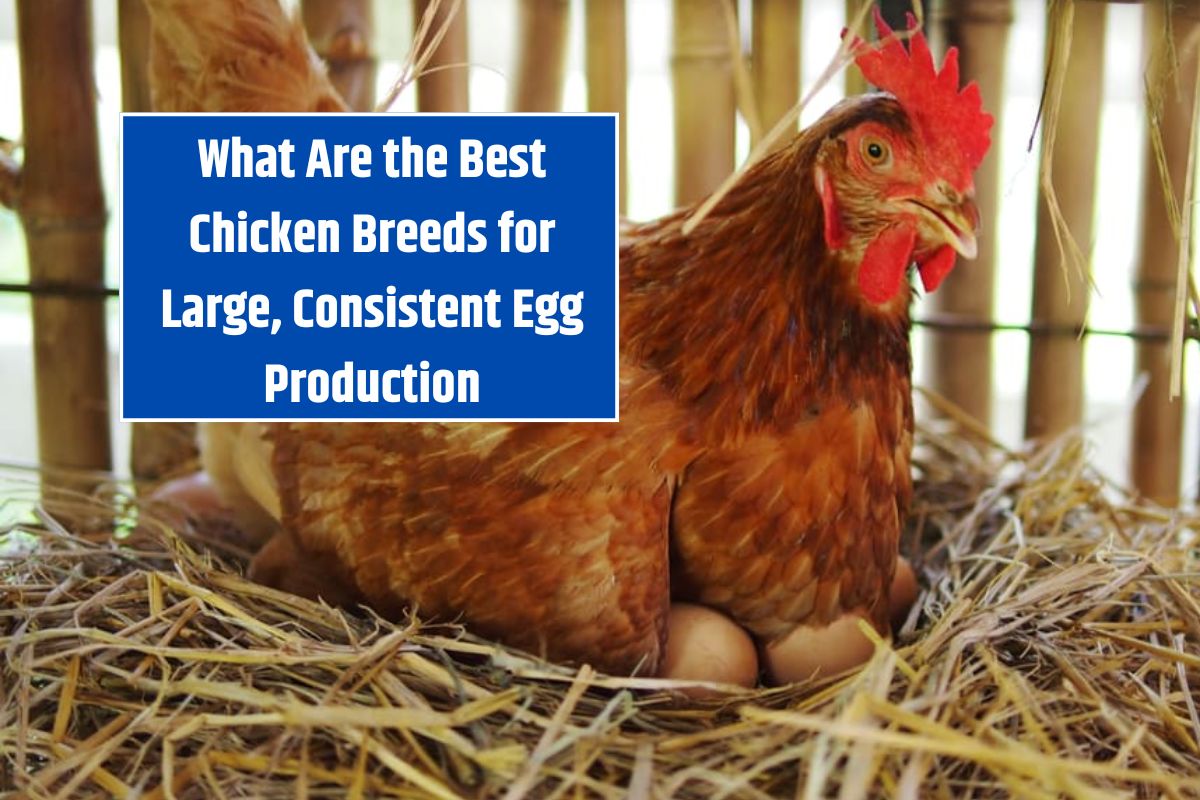Believe it or not, the classification of chicken eggs is based on their weight, not size. The weight of an egg determines its classification, from Pee-wee through Jumbo, as defined by precise measurements used by grocery stores. For backyard chicken keepers, understanding which breeds are best for large eggs and how to optimize egg production can help you get the most out of your flock.
Understanding Egg Classifications by Weight
As documented by the Egg Safety Center, eggs are classified by weight using the following general standards:
| Egg Size | Weight per Dozen |
|---|---|
| Pee-Wee | Less than 15 oz |
| Small | 18 oz |
| Medium | 21 oz |
| Large | 24 oz |
| Extra Large | 27 oz |
| Jumbo | 30 oz |
Initially, all hens start by laying small eggs (Pee-wee or Small) when they begin production. As they mature, their eggs increase in size, typically reaching Medium to Jumbo by around 40 weeks of age, depending on the breed and conditions.
Top Chicken Breeds That Lay Large Eggs
Some chicken breeds are selectively bred to produce larger eggs consistently. Here are the top breeds known for laying Large to Jumbo eggs:
1. Leghorn
- Egg Color: White
- Egg Size: Large to Extra Large
- Egg Production: 280-320 eggs per year
Why They’re Great: Leghorns are prolific layers and are commonly used in commercial egg production. They start laying early and consistently produce large white eggs.
2. Rhode Island Red
- Egg Color: Brown
- Egg Size: Large
- Egg Production: 260-300 eggs per year
Why They’re Great: Rhode Island Reds are dual-purpose birds, known for both their meat and egg production. Their large brown eggs and hardy nature make them a backyard favorite.
3. Sussex
- Egg Color: Cream to Light Brown
- Egg Size: Large
- Egg Production: 250-280 eggs per year
Why They’re Great: Sussex chickens are friendly, low-maintenance birds that consistently produce large eggs even in winter.
4. Australorp
- Egg Color: Light Brown
- Egg Size: Large to Extra Large
- Egg Production: 250-300 eggs per year
Why They’re Great: Known for their calm nature and reliable egg production, Australorps are excellent backyard chickens.
5. Plymouth Rock (Barred Rock)
- Egg Color: Light Brown
- Egg Size: Large
- Egg Production: 200-280 eggs per year
Why They’re Great: Plymouth Rocks are friendly, hardy, and consistent layers, making them ideal for small backyard flocks.
6. Buff Orpington
- Egg Color: Light Brown
- Egg Size: Large
- Egg Production: 200-280 eggs per year
Why They’re Great: Buff Orpingtons are known for their calm, gentle temperament and large, high-quality eggs.
Factors That Affect Egg Size
While breed plays a significant role in determining egg size, several factors can influence how quickly your hens reach optimal egg size and the overall quality of their production.
1. Age of the Hen
- Young hens start with smaller eggs and gradually lay larger eggs as they mature. By around 40 weeks, most breeds will produce Large to Extra Large eggs.
- Egg size continues to increase until the hen reaches peak maturity, after which it stabilizes.
2. Body Weight and Overall Health
- A healthy, well-fed hen will produce larger eggs than an undernourished one.
- Maintaining the ideal body weight ensures hens have the energy and nutrients to produce large eggs consistently.
3. Protein Levels in Diet
- Protein is essential for egg production, as eggs are rich in protein. Adjusting the protein content in feed can influence egg size during the early stages of production.
How to Optimize Egg Size Through Diet
Early Egg Production (First 2-3 Months)
- Feed your flock a diet with 18%-20% protein to help them lay larger eggs during the first few months of production.
- Why It Works: During early production, higher protein levels help hens develop the muscle and tissue necessary for larger eggs.
Peak Production (After 8-10 Months)
- Switch to a feed with 15%-17% protein to maintain egg size while preventing excessive weight gain.
- Why It’s Important: Continued high-protein diets after peak production can lead to overweight hens, reducing their overall health and egg production.
Additional Nutrients to Consider:
- Calcium: Essential for strong eggshells. Provide oyster shells or calcium supplements if needed.
- Omega-3 Fatty Acids: Can improve the quality and nutritional content of eggs.
Other Tips for Healthy Egg Production
- Maintain consistent lighting: Chickens need about 14-16 hours of light per day for optimal egg production.
- Provide clean, fresh water: Hydration is critical for egg production, as eggs are about 75% water.
- Minimize stress: Stressful conditions, such as overcrowding or predator threats, can negatively impact egg size and production.
Choosing the right breed and providing proper nutrition are key to getting Large, Extra Large, or even Jumbo eggs from your hens. Start with breeds known for producing large eggs, and support their growth with high-protein diets during the early stages of production. By maintaining the ideal balance of protein, calcium, and overall care, you’ll ensure a productive flock with healthy, large eggs.
FAQ’s
Q1: Which chicken breed lays the largest eggs?
A1: Leghorns, Australorps, and Rhode Island Reds are among the top breeds for laying Large to Jumbo eggs consistently.
Q2: How can I make my hens lay bigger eggs?
A2: Provide a high-protein diet (18%-20%) during early egg production, maintain healthy body weight, and ensure proper hydration and calcium intake.
Q3: Do older hens lay bigger eggs?
A3: Yes, as hens mature, their eggs typically increase in size. However, after a certain point, egg size stabilizes, and older hens may lay fewer eggs.
Q4: Can overfeeding protein harm my hens?
A4: Yes, after peak production (8-10 months), excessive protein can cause unnecessary weight gain, leading to health problems. Reduce protein levels to 15%-17% for maintenance.

















